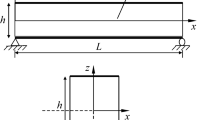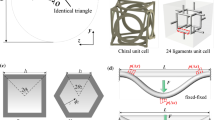Abstract
Surface stress was incorporated into the finite element absolute nodal coordinate formulation in order to model elastic bending of nanowires in large deformation. The absolute nodal coordinate formulation is a numerical method to model bending structures in large deformation. The generalized Young-Laplace equation was employed to model the surface stress effect on bending nanowires. Effects from surface stress and large deformation on static bending nanowires are presented and discussed. The results calculated with the absolute nodal coordinate formulation incorporated with surface stress show that the surface stress effect makes the bending nanowires behave like softer or stiffer materials depending on the boundary condition. The surface stress effect diminishes as the dimensions of the bending structures increase beyond the nanoscale. The developed algorithm is consistent with the classical absolute nodal coordinate formulation at the macroscale.
Similar content being viewed by others
References
Feng XL, He RR, Yang PD, Roukes ML (2007) Very high frequency silicon nanowire electromechanical resonators. Nano Lett 7(7): 1953–1959
Craighead HG (2000) Nanoelectromechanical systems. Science 290(5496): 1532–1535
Jing GY, Duan HL, Sun XM, Zhang ZS, Xu J, Li YD, Wang JX, Yu DP (2006) Surface effects on elastic properties of silver nanowires: contact atomic-force microscopy. Phys Rev B 73(23): 235409
Nilsson SG, Borrise X, Montelius L (2004) Size effect on Young’s modulus of thin chromium cantilevers. Appl Phys Lett 85(16): 3555–3557
Husain A, Hone J, Postma HWC, Huang XMH, Drake T, Barbic M, Scherer A, Roukes ML (2003) Nanowire-based very-high-frequency electromechanical resonator. Appl Phys Lett 83(6): 1240–1242
Li M, Mayer TS, Sioss JA, Keating CD, Bhiladvala RB (2007) Template-grown metal nanowires as resonators: performance and characterization of dissipative and elastic properties. Nano Lett 7(11): 3281–3284
He J, Lilley CM (2008) Surface effect on the elastic behavior of static bending nanowires. Nano Lett 8(7): 1798–1802
Gao W, Yu SW, Huang GY (2006) Finite element characterization of the size-dependent mechanical behavior in nanosystems. Nanotechnology 17: 1118–1122
Park HS, Klein PA, Wagner GJ (2006) A surface Cauchy-Born model for nanoscale materials. Int J Numer Method Eng 68(10): 1072–1095
Shabana AA (1996) An absolute nodal coordinate formulation for the large rotation and deformation analysis of flexible bodies. Technical Report MBS96-1-UIC, University of Illinois at Chicago, Chicago
Zhou LG, Huang HC (2004) Are surfaces elastically softer or stiffer. Appl Phys Lett 84(11): 1940–1942
Ji CJ, Park HS (2007) Characterizing the elasticity of hollow metal nanowires. Nanotechnology 18(11): 115707
Ji CJ, Park HS (2007) The coupled effects of geometry and surface orientation on the mechanical properties of metal nanowires. Nanotechnology 18(30): 305704
Liang HY, Upmanyu M, Huang HC (2005) Size-dependent elasticity of nanowires: Nonlinear effects. Phys Rev B 71(24): 241403
Shabana AA, Yakoub RY (2001) Three dimensional absolute nodal coordinate formulation for beam elements: theory. J Mech Des 123(4): 606–613
Yakoub RY, Shabana AA (2001) Three dimensional absolute nodal coordinate formulation for beam elements: Implementation and applications. J Mech Des 123(4): 614–621
Maqueda LG, Bauchau OA, Shabana AA (2008) Effect of the centrifugal forces on the finite element eigenvalue solution of a rotating blade: a comparative study. Multibody Syst Dyn 19(3): 281–302
Sopanen JT, Mikkola AM (2003) Description of elastic forces in absolute nodal coordinate formulation. Nonlinear Dyn 34(1–2): 53–74
Hussein BA, Sugiyama H, Shabana AA (2007) Coupled deformation modes in the large deformation finite-element analysis: problem definition. J Comput Nonlinear Dyn 2: 146–154
Chen TY, Chiu MS, Weng CN (2006) Derivation of the generalized Young-Laplace equation of curved interfaces in nanoscaled solids. J Appl Phys 100(7): 074308
Wan J, Fan YL, Gong DW, Shen SG, Fan XQ (1999) Surface relaxation and stress of fcc metals: Cu, Ag, Au, Ni, Pd, Pt, Al and Pb. Model Simul Mater Sci Eng 7(2): 189–206
Chen YX, Dorgan BL, McIlroy DN, Aston DE (2006) On the importance of boundary conditions on nanomechanical bending behavior and elastic modulus determination of silver nanowires. J Appl Phys 100(10): 104301
Cuenot S, Fretigny C, Demoustier-Champagne S, Nysten B (2004) Surface tension effect on the mechanical properties of nanomaterials measured by atomic force microscopy. Phys Rev B 69(16): 165410
Author information
Authors and Affiliations
Corresponding author
Rights and permissions
About this article
Cite this article
He, J., Lilley, C.M. The finite element absolute nodal coordinate formulation incorporated with surface stress effect to model elastic bending nanowires in large deformation. Comput Mech 44, 395–403 (2009). https://doi.org/10.1007/s00466-009-0380-9
Received:
Accepted:
Published:
Issue Date:
DOI: https://doi.org/10.1007/s00466-009-0380-9




